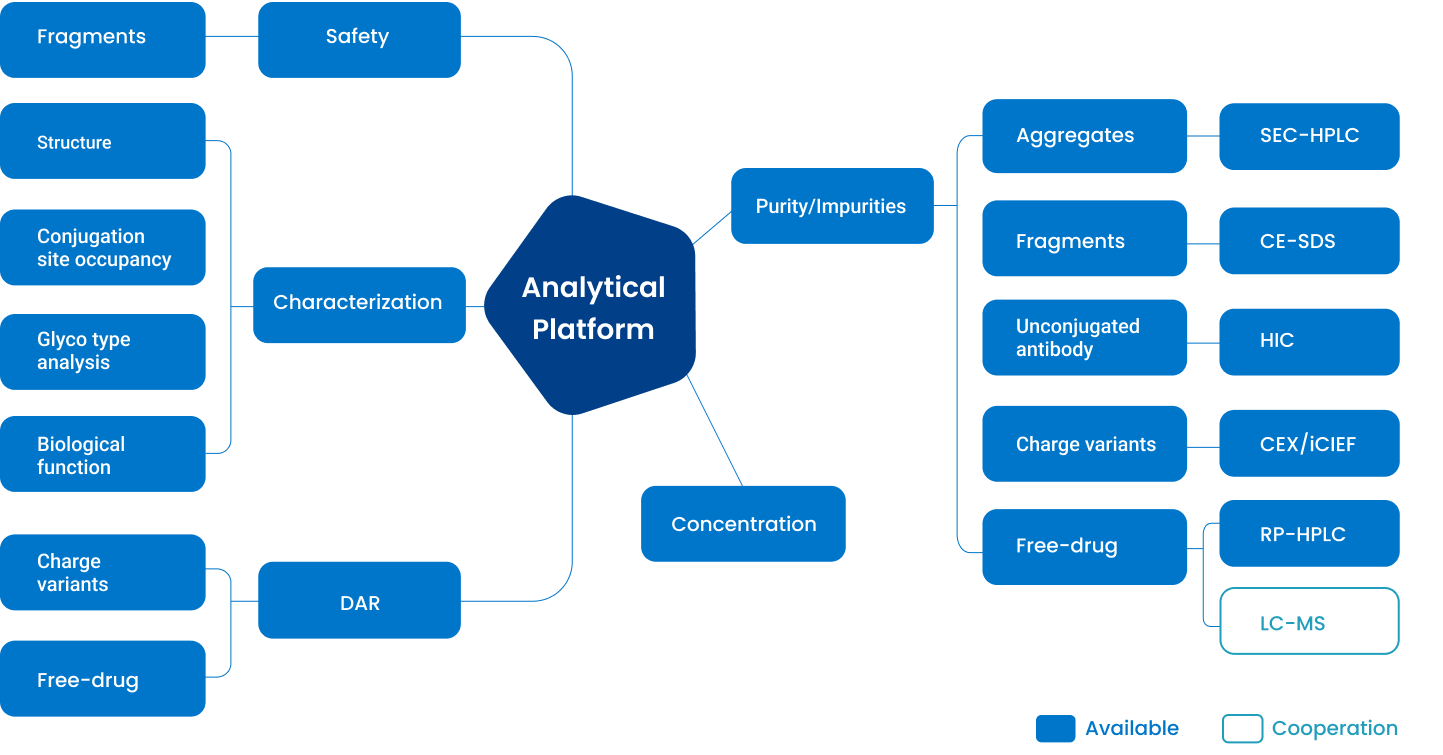How to choose the right conjugation strategy for your Antibody Drug Conjugation development?
| Conjugation methods | Schematic diagram | Advantages | |
|---|---|---|---|
| Non-site specific conjugation |
Lysine sites |  |
• Rapid and convenient |
| Reduced cysteine sites |
 |
• A relatively homogeneous product | |
| Site-specific conjugation |
Engineered reactive cysteine residues |
 |
• High homogeneity; •Tunable reactivity and stability |
| Disulfide re-bridging |
 |
• High homogeneity; •No influence on spatial structure of antibody; •National amino acid sequence and glycosylation |
|
| Unnatural amino acids |
 |
•High homogeneity; •Tunable reactivity and stability; •High efficiency of conjugation |
|
| Enzyme-assisted ligation |
 |
•High homogeneity; •High efficiency of conjugation •DAR alteration possible |
|
| Glycan remodeling and glycoconjugation |
 |
•High homogeneity; •No alteration of amino acid sequence |
|
| pClick technology |  |
•Without antibody engineering or chemical / enzymatic treatments •Simple, efficient, and convenient |
ChemExpress ADC Conjugation Services
Choose proper chemistry conjugation methods according to your unique needs, ChemExpress's ADC conjugation technology services are available in various formats, including FFS, FTE, and CMC, providing services such as conjugate drug screening, conjugation process development and optimization, and conjugate sample preparation. ChemExpress R&D team employs multiple methods for the synthesis of bioconjugates between payloads and macromolecules. Our bioconjugation experience includes various carriers, and we offer an extensive library of linkers and payloads for your R&D purposes, as demonstrated below. Contact us for more information and a detailed quote.

-
Drug carrierMonoclonal antibody
Bispecific antibody ThioMab
Antibody Fragments Aptamer -
Conjugation methodsLysine sites Cysteine sites
Unnatural amino acids
Transglutaminase
ThioBridge-like -
PayloadsMMAE, Exatecan, Eribulin,
DXd PBD, Tublysin
Doxorubicin Etc.
ChemExpress ADC Analytical Platform
Biomolecules like ADCs are complex and require thorough analytical assessment to ensure safety and quality. At ChemExpress, we leverage our in-house expertise and advanced analytical equipment to characterize key intermediates, including proteins/mAbs, payloads, and linkers. To streamline your project and ensure scalability, our experienced R&D and analytical teams work closely together to develop processes that meet your specific quality attributes. The methods used to assess and characterize these complex bioconjugate molecules include:

Next-generation bioconjugates and the future of ADCs
With the continuous progress of chemical conjugation, protein genetic engineering and other technologies, the field of targeted delivery of drug conjugates is not limited to ADCs, and various types of drug conjugates have been generated. For example, a peptide‒drug conjugate (PDC) comprises a homing peptide, payload and linker. Degrader-antibody conjugates (DACs) that combine a proteolysis targeting chimera (PROTAC) payload with a monoclonal antibody via some type of chemical linker. In radionuclide drug conjugates (RDCs), another innovative form of medical imaging and treatment, tumor antigen-specific targeting antibodies or Payload-Linkers are connected by linkers to radioisotopes (both imaging and radiokilling), which enables accurately guided radionuclide delivery to tumors for diagnosis or treatment. Other examples include peptide-oligonucleotide conjugates (POCs), Payload-Linker–drug conjugates (SMDCs), virus-like drug conjugates (VDCs), antibody–oligonucleotide conjugates (AOCs), antibody–cell conjugates (ACCs), immune-stimulating antibody conjugates (ISACs), antibody fragment–drug conjugates (FDCs), antibody–degrader conjugates (ADeCs), and aptamer–drug conjugates (ApDCs).
Such novel approaches to bioconjugates opens doors to new mechanisms of action, therapies, and indications. With expertise and dedication, advanced ADC bioconjugation platform and services from ChemExpress will be your best companion in creating customized ADCs.
Partner with ChemExpress
ChemExpress maintains a substantial inventory of over 80 payloads and 400 linkers and can customize the synthesis of payload-linkers to meet client needs. With extensive experience in linker compound synthesis, having successfully completed over 1,000 syntheses, our experienced technical team is dedicated to providing end-to-end, one-stop solutions for Antibodies and ADCs, providing antibodies, payload linkers, conjugates and drug products to biotech & pharma from R&D to commercialization. Contact a ChemExpress representative for more information.
-
80+ Payloads
400+ Linkers
1000+ Linker Syntheses
-
Large-scale payloads and
linkers GMP manufacturing -
Advanced technologies
and methodologies -
50+ CMC Projects,
1 Commercial Project
-
13 FDA DMFs,
offering High-quality and cost-effective products -
Passed US FDA inspection
with zero 483 observations -
Integrated ADC DS & DP CDMO
platform for commercialization

- [1] Sig Transduct Target Ther. 2022
- [2] Angew Chem Int Ed Engl. 2021
- [3] Antibody Therapeutics. 2020
- [4] Zhou et al.Experimental Hematology & Oncology. 2024
Download Our ADC Handbook
-
ChemExpress ADC Products handbook (ADC)
Apply


